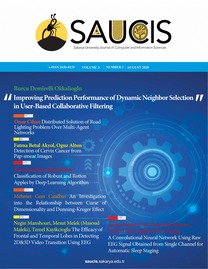Kurşun Asit Aküler İçin Kalıcı Sülfatlaşmayı Ortadan Kaldıran Yenilikçi Bir Akü Koruma Cihazı Tasarımı
An Innovative Battery Protection Device Design That Eliminates Permanent Sulphation for Lead Acid Batteries
___
[1] J. Jung, L. Zhang, J. Zhang, Lead-acid Battery Technologies: Fundamentals, Materials, and Applications, CRC Press, 2015.[2] M. Barak, Electrochemical Power Sources, Peter Peregrinus, England, 1980.
[3] Z. Zhuo et al.,"Screening and assessment of solidification/stabilization amendments suitable for soils of lead-acid battery contaminated site." Journal of Hazardous Materials, vol.288, pp. 140-146, 2015.
[4] Z. M. Salameh, M. A. Casacca, W. A. Lynch, "A mathematical model for lead-acid batteries,"IEEE Transactions on Energy Conversion, vol. 7(1), pp. 93-98, 1992.
[5] R. J. Brodd, K. R. Bullock, R. A. Leising, R. L. Middaugh, J. R. Miller, E. Takeuchi, "Batteries from 1977 to 2002," Journal of the Electrochemical Society, vol.151(3), 2004.
[6] C. J. Rydh, "Environmental assessment of vanadium redox and lead-acid batteries for stationary energy storage,", Journal of Power Sources, vol. 80(1), pp. 21-29, 1999.
[7] D. H. Doughty, P. C. Butler, A. A. Akhil, N. H. Clark, and J. D. Boyes, "Batteries for largescale stationary electrical energy storage," The Electrochemical Society Interface, vol. 19(3), pp. 49– 53, 2010.
[8] D. W. G. Lambert et al., “Advances in gelled electrolyte technology for valve- regulated leadacid batteries,” Journal of Power Sources, vol. 107, 173–179, 2002.
[9] R. C. Weast, CRC Handbook of Chemistry and Physics. CRC, Boca Raton-FL, pp. 254, 1978.
[10] K. R. Bullock, "The electromotive force of the lead acid cell and its half-cell potentials", Journal of Power Sources, vol. 35(3), pp.197-223, 1991.
[11] V. Danel, V. Plichon. "Study of Pb (II) in various H2O-H2SO4 mixtures by differential pulse polarography: solubility of lead sulphate, diffusion coefficient of Pb (II) and half-wave potential of Pb (Hg)/Pb (II)," Electrochimica Acta, vol. 27(6), pp. 771-774, 1982.
[12] D. N. Craig, and N. Vinal. "Solubility of lead sulfate in solutions of sulfuric acid, determined by dithizone with a photronic cell." J. Res. Natl. Bur. Stand, vol.22, pp. 55-70, 1939.
[13] D. Polov, "Lead-Acid Batteries, Technology and Operation", KLT-13, Hangzhou, China, 2000,
[14] Z. Li, Lecture Course on VRLA, China, 2003.
- ISSN: 2636-8129
- Yayın Aralığı: Yılda 3 Sayı
- Başlangıç: 2018
EOG İşaretini Kaynak İşaret Olarak Kullanmak Üzere Etkin Özelliklerin Belirlenmesi
İlhan ZENGİN, Mehmet Recep BOZKURT, MUHAMMED KÜRŞAD UÇAR
Design Tradeoffs in Full Electric, Hybrid and Full Chemical Propulsion Communication Satellite
An Analysis of the Characteristics of Verified Twitter Users
Abdullah Talha KABAKUS, MEHMET ŞİMŞEK
Hafif Sıklet Şifreleme Algoritmalarının Performans Karşılaştırması
